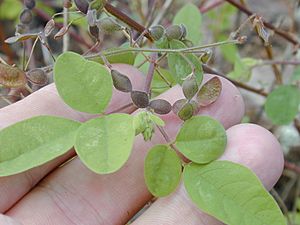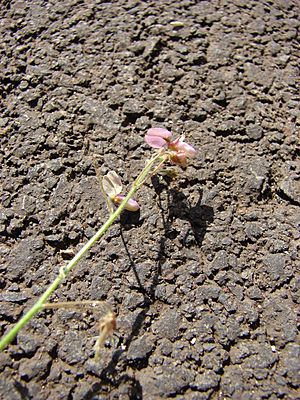Twisted tick trefoil facts for kids
Quick facts for kids Twisted tick trefoil |
|
|---|---|
 |
|
| Leaves and seedpods | |
 |
|
| Flower | |
| Scientific classification | |
| Genus: |
Desmodium
|
| Species: |
tortuosum
|
| Synonyms | |
|
List
|
|
Desmodium tortuosum, also known as the twisted tick trefoil or Florida beggarweed, is a type of flowering plant. It belongs to the Fabaceae family, which is also called the pea or bean family. This plant is special because its seeds can stick to clothes or animal fur, helping them travel to new places!
Contents
What is Twisted Tick Trefoil?
The twisted tick trefoil is a plant that can grow quite tall. It gets its name from its seedpods, which are often twisted and have tiny hooks. These hooks help the seeds cling to things, like a "tick" on clothing. It's also called "beggarweed" because of how its seeds "beg" for a ride.
Common Names for the Plant
This plant has many different common names. Some people call it the dixie tick trefoil or tall tick clover. In Florida, it's often known as Florida beggarweed or giant beggar weed. All these names describe different features of the plant, like its height or how its seeds behave.
Plant Family: The Fabaceae
Desmodium tortuosum is part of the Fabaceae family. This is a very large and important group of plants. It includes many plants we eat, like peas, beans, and lentils. Plants in this family are known for their special ability to improve soil. They can take nitrogen from the air and put it into the soil, which helps other plants grow better.
Where Does This Plant Grow?
The twisted tick trefoil is originally from Latin America. This means it naturally grew there first. Over time, people have moved it to many other parts of the world. Now, you can find it in many warm, sunny places.
Native Home and New Places
Its native home includes countries in Central America, the Caribbean, and parts of South America like Brazil and Venezuela. It also grows in Mexico and Argentina. Because it's so useful, it has been introduced to many other subtropical and tropical regions around the globe. This means it was brought there by people and now grows wild.
Why is This Plant Important?
One of the main reasons Desmodium tortuosum is important is its use as forage. Forage is plant material eaten by grazing animals, like cows, goats, and sheep. This plant provides good food for these animals.
A Good Food for Animals
Farmers often grow twisted tick trefoil in their fields. It's a healthy and nutritious food source for livestock. Animals can eat its leaves and stems, which helps them grow strong. This makes the plant very valuable for farming in many parts of the world.
Helping the Soil
Like other plants in the pea family, Desmodium tortuosum can also help the soil. It has special bacteria on its roots that can take nitrogen from the air. This nitrogen then goes into the soil, acting like a natural fertilizer. This makes the soil healthier for other plants to grow, which is good for the environment and for farmers.
What Does the Plant Look Like?
The twisted tick trefoil is an interesting plant to observe. It has distinct leaves, pretty flowers, and unique seedpods.
Leaves and Stems
The leaves of Desmodium tortuosum are usually made up of three smaller leaflets. They are green and can grow quite large. The plant itself can grow tall, sometimes reaching over 6 feet (about 2 meters) in height. Its stems are often covered in fine hairs.
Flowers and Their Colors
The flowers of this plant are small and often appear in clusters. They can be a pretty pink or purple color. These flowers attract insects, like bees, which help the plant make seeds. The flowers bloom during the warmer months.
Unique Seedpods
The most distinctive part of the plant might be its seedpods. They are long and narrow, often appearing twisted or coiled. Each pod is divided into several small segments, and each segment contains one seed. These segments are covered in tiny, hooked hairs. When the pods are mature, they break apart easily. The hooks on the segments allow them to stick to fur, feathers, or clothing, which is how the seeds spread far and wide.
Life Cycle of the Plant
Desmodium tortuosum is an annual plant. This means it completes its entire life cycle, from seed to flower to seed, within one growing season.
From Seed to Plant
The plant starts its life as a tiny seed. When the weather is warm and there is enough moisture, the seed sprouts. It grows roots into the soil and a stem upwards towards the sun.
Growing and Flowering
As the plant grows, it develops its leaves and gets taller. Once it's mature enough, it starts to produce flowers. These flowers are pollinated, usually by insects, and then they develop into the special seedpods.
Spreading Seeds
After the seeds mature inside the pods, the pods break apart. The hooked segments then attach to anything that brushes past them. This is a very effective way for the plant to spread its seeds to new areas. Once the seeds are dispersed, the parent plant usually dies, completing its life cycle. The new seeds will then wait for the right conditions to start the cycle all over again.
Images for kids



